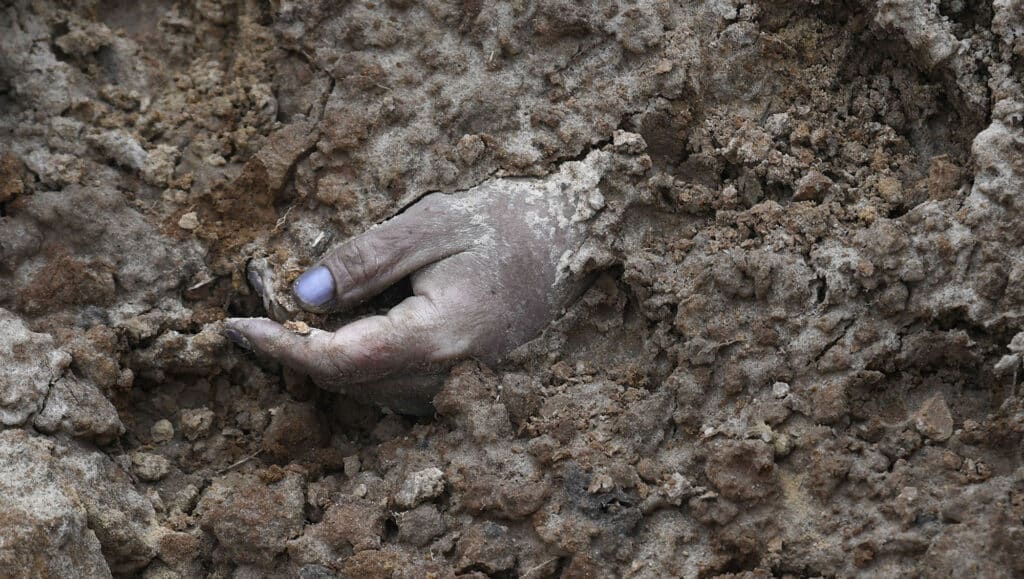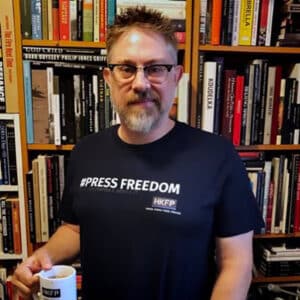In February 2022, Russia invaded Ukraine, touching off a bloody war, resulting in the deaths of thousands of civilians and driving a massive refugee crisis. As Russian forces have been driven back from their early advances, the scale and scope of their crimes have come to light.
“You see a corpse with their hands tied behind their back, tied with plastic packaging tape because that’s what the Russians could find inside this building. So they used whatever they could find, whether it was a power cord or something else. But they just used it so it was easier to kill them, to assassinate them.”
Award winning photojournalist Paula Bronstein recounted this from her hotel room in Lviv on a Sunday evening in early May 2023. It is just over a year since the Russian military invaded Ukraine on February 24, 2022, seizing swaths of the country, and attempting to capture the capital of Kyiv. For weeks leading up to the invasion, Russian troops had been massing along Ukraine’s borders. Diplomacy went nowhere. Many feared that Ukraine would be quickly overrun and fall to the invaders.
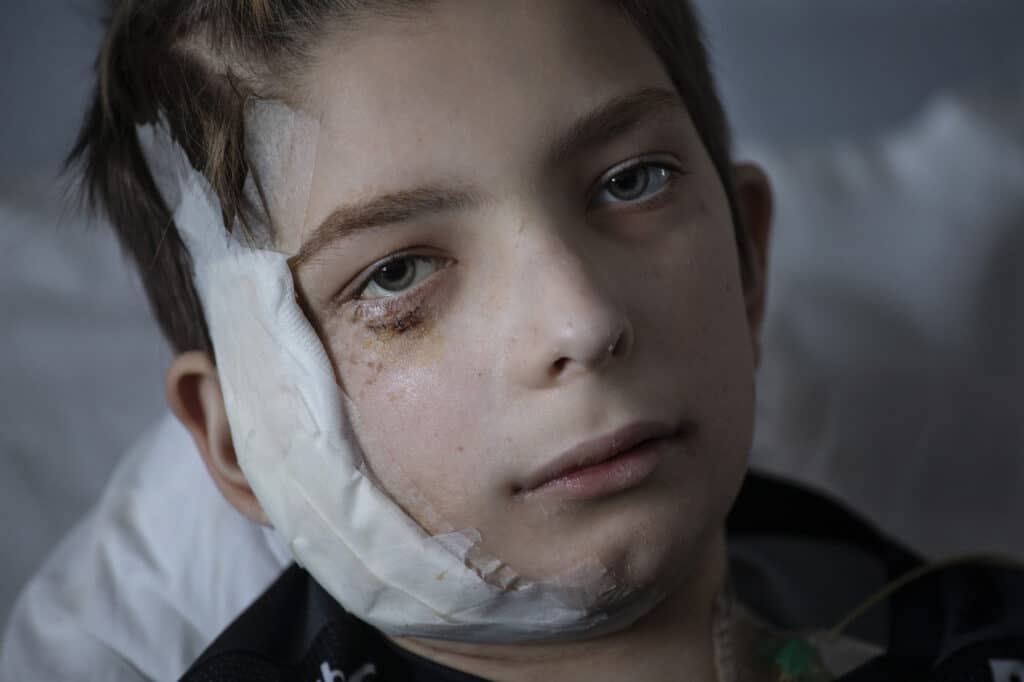
“This is the most well covered war I’ve ever seen or experienced”
But the country and its people still stand strong. The Ukrainian army has not collapsed, the government is still in place, and the country has not been overrun. The fighting has laid waste to cities and towns. And there are few, if any, signs it will end soon. Bombs and drones continue to rain down on civilian population areas. Critical infrastructure has been targeted and destroyed. Hospitals and places civilians take shelter have been attacked. Thousands of civilians have been killed and wounded, and millions have fled the fighting. The invasion has created over 8 million Ukrainian refugees across Europe According to the UNHCR, the largest refugee crisis in Europe since World War II.
And as the Russian Army has been thrown back from areas it controlled, the evidence of the war crimes it committed in its occupation have come to light. And Bronstein is not the only witness to such atrocities. There has been a massive corps of Ukrainian and International photojournalists covering the front lines, the refugee crisis, and the human rights violations that have appeared following the retreat of Russian forces. Bronstein said she has never seen coverage like it.
“I would say this is the most well covered war I’ve ever seen or experienced. Never have I seen anything that matched it in terms of coverage, in terms of the amount of extraordinary work that’s been done and the visual messages that come across because each photographer has their own signature.”
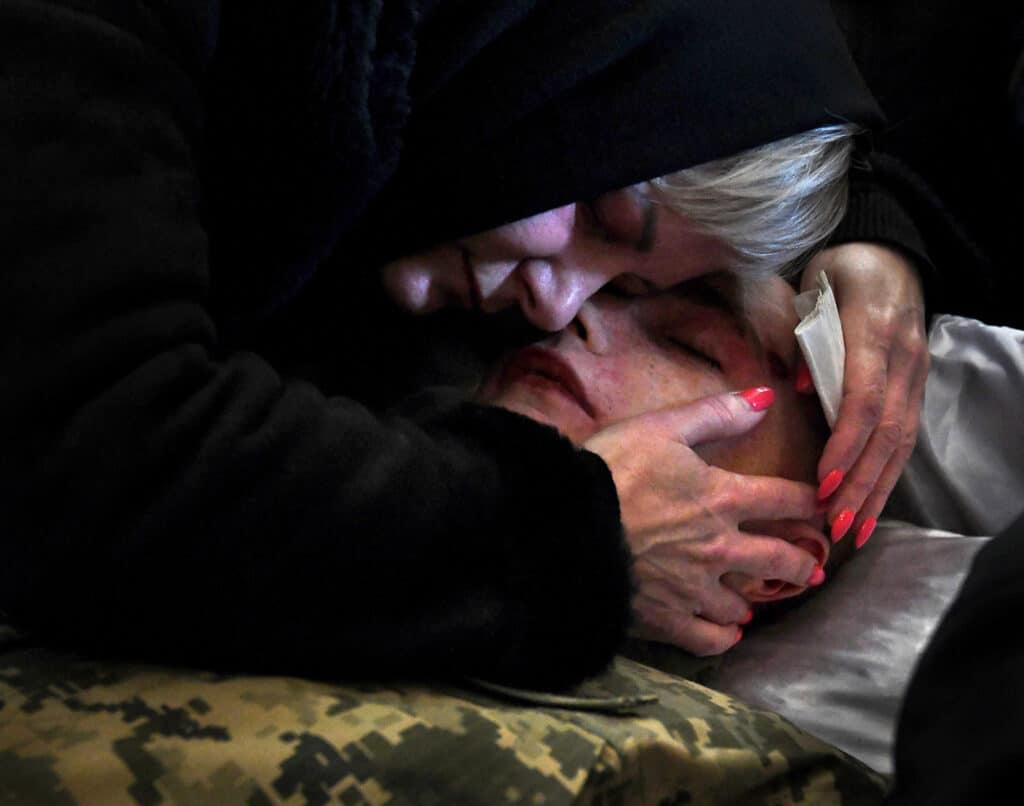
93 photojournalists
The FotoEvidence Book Award is usually given to an individual photographer for a project on human rights chosen from submissions. But with the Russian invasion of Ukraine, Svetlana Bachevanova, the publisher of FotoEvidence, decided to change direction for this year.
“When Russia invaded Ukraine and we witnessed what Russians are capable of again I decided to dedicate the 2023 FotoEvidence Book Award to the war crimes committed on Ukrainian soil. There are stories and images in the book that cannot be denied and will be remembered.”
This decision changed not just the usual way FotoEvidence accepts applications from photographers for their specific projects, but also changed the usual format of selecting a single photographer. “The war in Ukraine called for a new approach: instead of providing opportunity for just one photographer, we felt the need to draw the photojournalism community together in a collective action to document the destruction of war, Russia’s indiscriminate, criminal violence and the power of Ukrainian identity.”
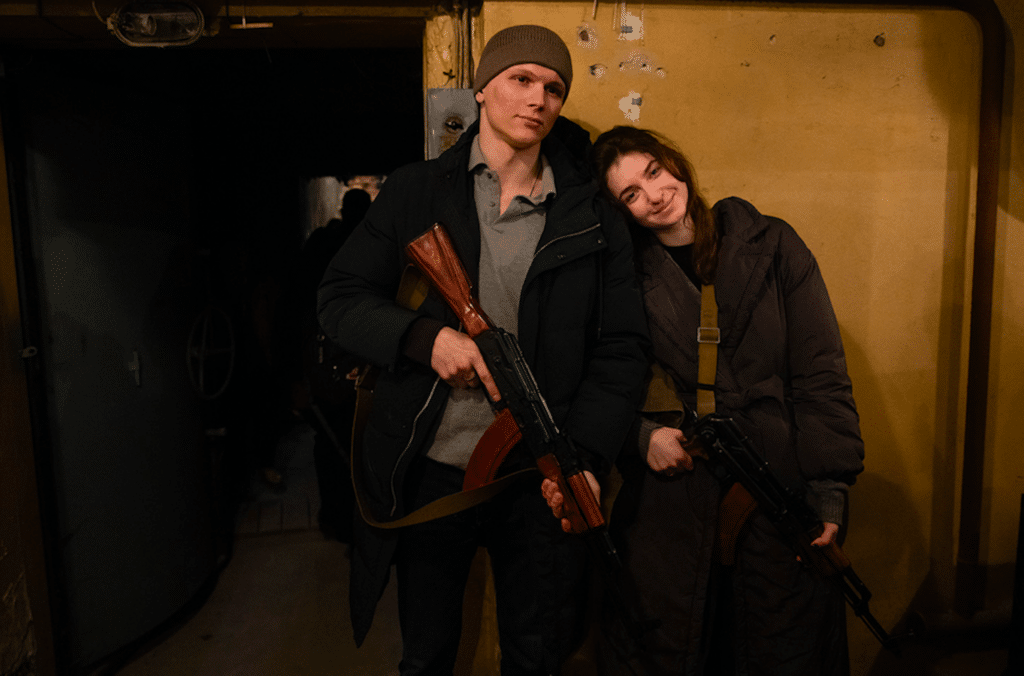
To gather the work for a book on the War in Ukraine, FotoEvidence put out an open call to photographers to send along photographs and witness accounts through their website, social media, and direct emails. They ended up receiving over 6000 photographs from more than 100 photographers along with written accounts.
From this trove of photographs and writings has come Ukraine: A War Crime. At 540 pages, the book contains 366 photographs and witness accounts, both in English and Ukrainian, from 93 photojournalists from 29 countries spanning the first year of the War in Ukraine. Its size and weight emphasizing the importance of the subject matter it contains.
FotoEvidence itself was created due to previous Russian atrocities. Bachevanova grew up in Bulgaria and has always been aware of what the Russians were capable of. “After the fall of the communist regime in 1989, the new, democratic media started to expose for the first time some of the crimes committed during the regime: concentration camps, mass graves, political assassinations. But there were no visual proofs of these atrocities. This is what led to the creation of the publishing house FotoEvidence and the FotoEvidence Book Award, one of the most prestigious in photojournalism.”
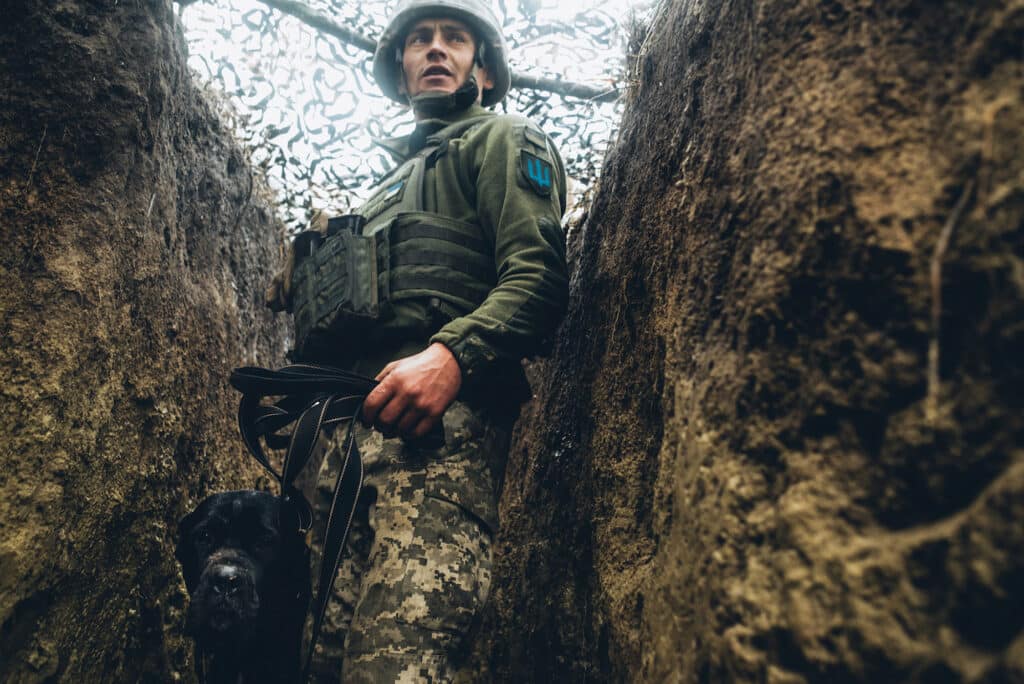
Organizing the submissions for Ukraine: A War Crime into a book, and the responsibility of getting it right, fell to Sarah Leen, the photo editor. “In all my years working as a photo editor on books and at the National Geographic magazine this was the greatest editing challenge I have ever faced. As a non-Ukrainian I felt a huge responsibility to “get it right,” to find a structure that worked to tell the story to those who were less familiar with the arc of the war and be true for the Ukrainians and the photographers experiencing it first-hand. I also worked with Irynka Hromotska, a young Ukrainian photo editor who I had met at the Missouri Photo Workshop in 2022. She gave me very important feedback from an insider’s perspective that was essential to the final edit of the book. “
The book is a tome to the horrors of war. As you look through its pages, you cannot escape the violence, the destruction, and the dead. They permeate every page. It is not just a documentation of a war, but the visual evidence of the war crimes committed on Ukrainian soil.
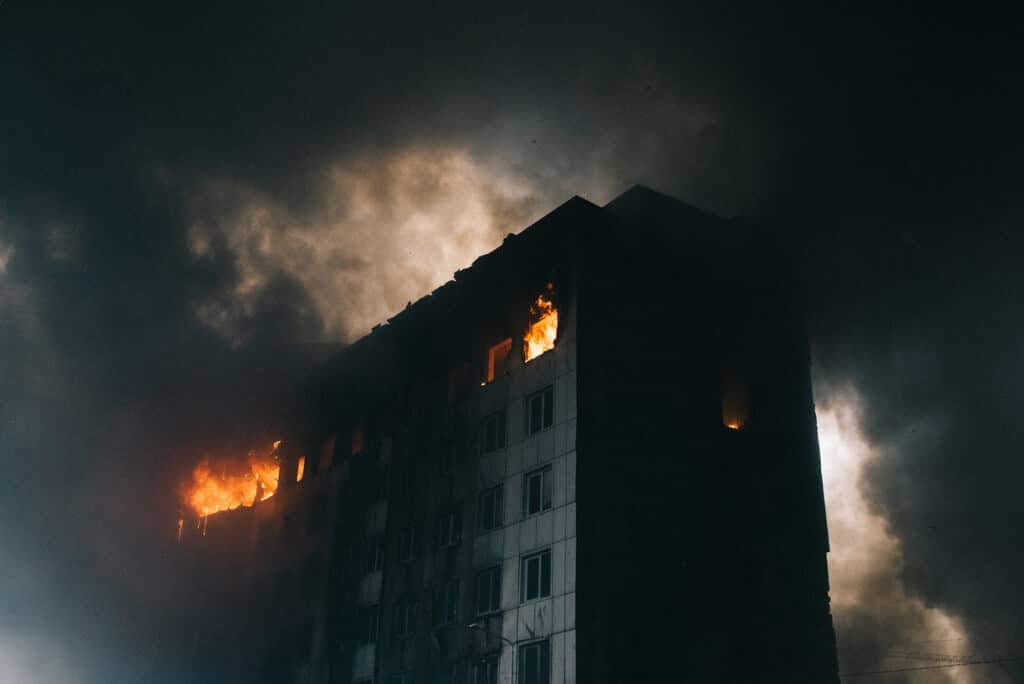
As you go through the book, which is divided into sections, you come across photographs of war, its aftermath, and its consequences. There are photographs of the faces of refugees framed by the train windows taking them to safety. Photos of civilians training for battle with wooden guns or learning how to throw Molotov cocktails. Photographs of destroyed and burning apartment buildings. Photographs of soldiers in the fields, or in their trenches and foxholes. Photographs of artillery batteries firing. Photographs of civilians surveying battle damage. These are photographs, that while heartbreaking and graphic, one sees from war zones around the world.
“In these images are the testimonies of the living and the dead, who speak in equal terms of all that has been endured”
Nicole Tung
But within the book’s pages are also the photographs which are the evidence of war crimes. A photograph of a man getting a stretcher ready to receive the body of a civilian killed on a bridge that was being used to evacuate noncombatants from Irpin. A photo of a hand poking through the earth at a mass grave in Bucha, the nail on the thumb a pale iridescent blue. The photo of an old women, hand covering her mouth, looking at three civilians’ bodies, two of whom are a father and son, killed in their own backyard.
And there are many more in the pages of the book. They are not easy to look at, but equally as hard to look away from once seen. These photographs speak of a horror in this war that not supposed to be, and a brutality that is hard to fathom. It is hard to imagine what must have occurred, even with photographs of its aftermath right before your eyes.
Photojournalist Nicole Tung puts it this way in the book’s text: “In these images are the testimonies of the living and the dead, who speak in equal terms of all that has been endured.”
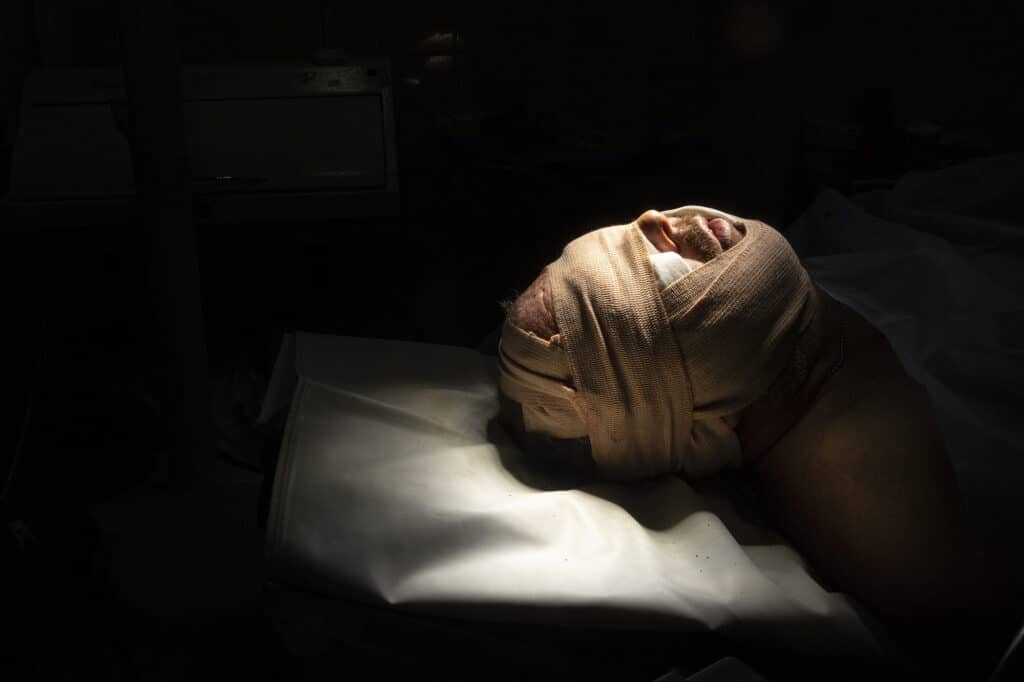
“War cripples human souls and bodies, destroys buildings, and harms nature“
There is a broad mix among the 93 photographers whose work appears in the book, who have covered every corner of the war. Some began covering Ukraine with the invasion in February 2022. Others have been documenting what has happened in Ukraine for much longer. But all are invested in telling the story, showing the lives that have been lost or changed forever, documenting the brutality that has been a hallmark of the war, and creating a record for the future.
Maxim Dondyuk, a Ukrainian photographer, began his work in 2013 and 2014. But he does not consider himself a war photographer. He had worked on artistic project not related to war until the Russians came. But he feels it is his duty to document the historical moment.
“I feel that this is my duty as a documentary photographer and as a Ukrainian to capture this historical moment for the present and the future. Today we are witnessing a final fight for Ukraine’s independence and democracy, the outcome of which is immensely important not just for the people of Ukraine, but also for a united Europe and the whole civilized world. War cripples human souls and bodies, destroys buildings, and harms nature. All that remains are destruction, pain, and suffering. It puts an unforgettable footprint on everything that touches.”
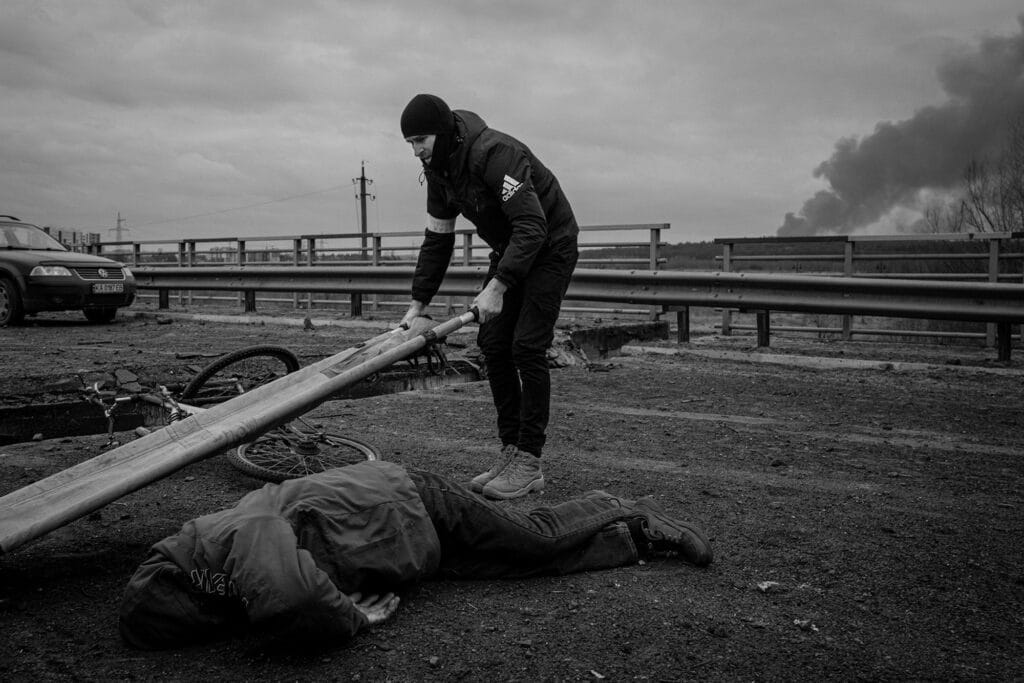
Like Dondyuk, Christopher Occhicone also began his work in 2014 “I came in august 2014 to stay with Battalion Donbas, a volunteer brigade fighting in eastern Ukraine. After I went back home, I had a few messages from wives of guys I met who had gone missing or were killed. It motivated me to go deeper and spend more time in the country. By 2017 I was a resident of Ukraine and living in Kyiv half the time. I understood that the only way to really cover the war was to learn the language and keep going to the east with the same soldiers.”
“In war you can feel a real sense of brotherhood with the people you are photographing. You also have to try to manage your hatred of the people doing this to them so that you can work in a clear way”
Christopher Occhicone
For Occhicone this extended closeness to his subjects combined with the horrific things he has seen and photographed also can make the work harder. “Not to be a cliche, but it is hell. When you have seen dozens of people executed in the streets, spent months in a field hospital and seen amputations and death, when you see civilian cars with dead families inside, then you know what war is. And it is horrible … In war you can feel a real sense of brotherhood with the people you are photographing. You also have to try to manage your hatred of the people doing this to them so that you can work in a clear way. It’s very hard.”
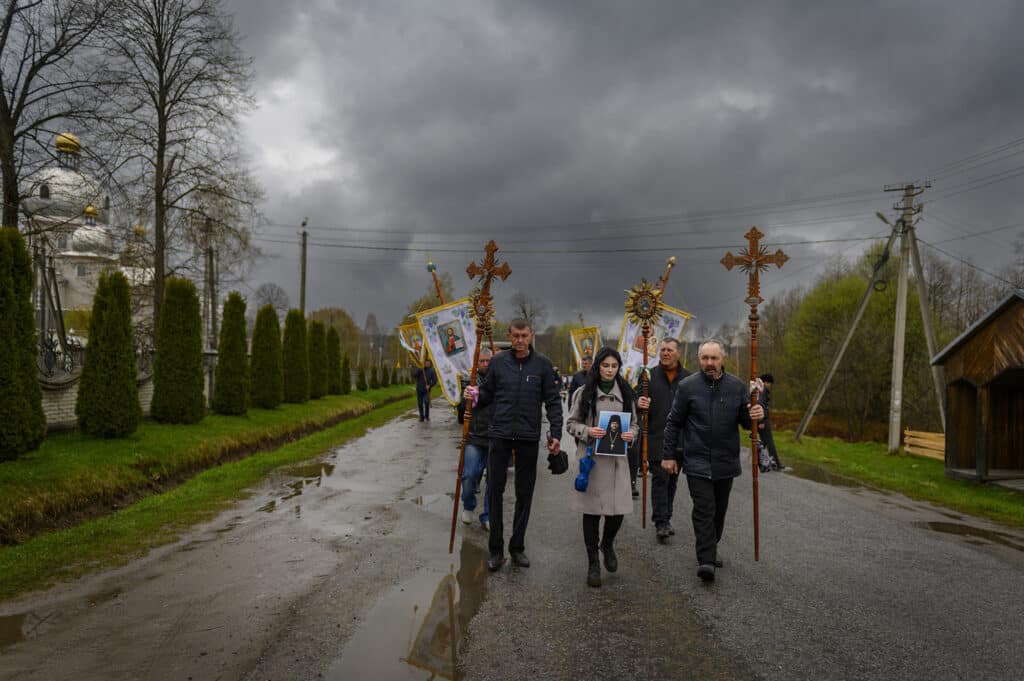
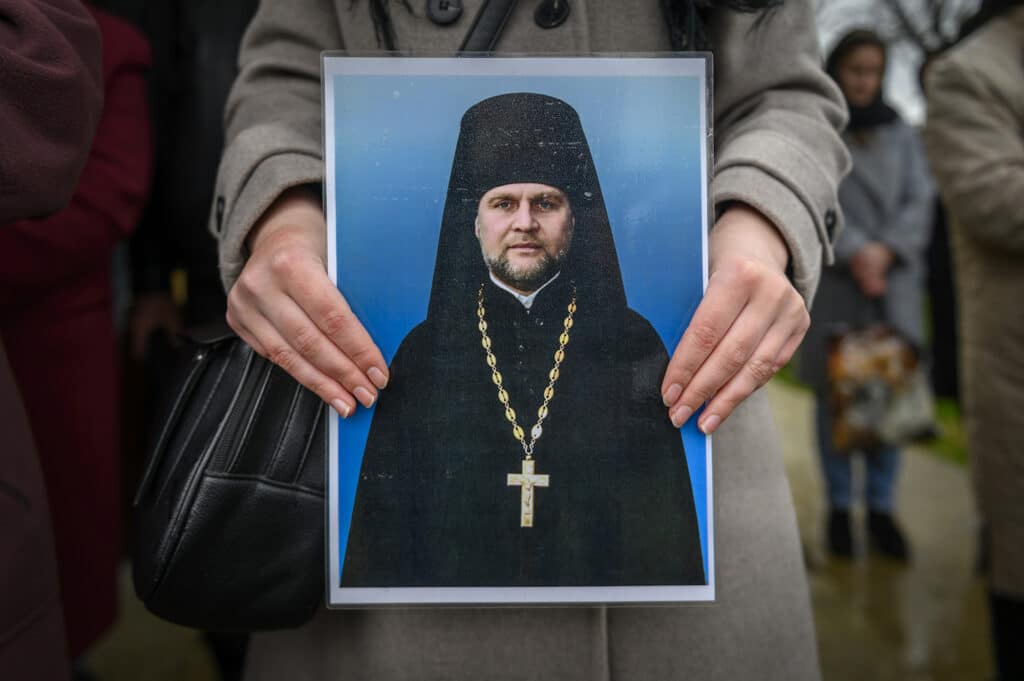
Byron Smith came to Ukraine a few days after the invasion, when he was assigned by a United Kingdom based NGO to photograph the refugee crisis stemming from the war along the Polish-Ukraine border. He eventually made his way into Ukraine, to cover the Battle for Kyiv. He went on to spend the better part of the year trying to capture as many aspects to the conflict as he could. Like the others, he hopes that the photographs in the book will connect to those see it to those involved. “I also want them to take away each image as a story of a moment in time that hopefully can bring the viewer into the frame and, just for a moment, connect with the images on a deep level.”
Bronstein also came to Ukraine after the start of the conflict. She was in Afghanistan when the war broke out, but once her commitment there was done, she headed to Ukraine. She is also again back in Ukraine, and working so people will not forget what’s going on, like has happened in other wars, particularly America’s war in Afghanistan. Bronstein knows well how Americans lost interest in the conflict, and priorities shifted. She does not want that to happen to Ukraine.
“It’s the same reason why I’m here again now. I’m not an assignment now. I’m continuing to try to produce good work on a very, very important story that I don’t want the world to forget about. And this goes back to my two decades of working in Afghanistan off and on. But this story to me is so different and so engaging.”
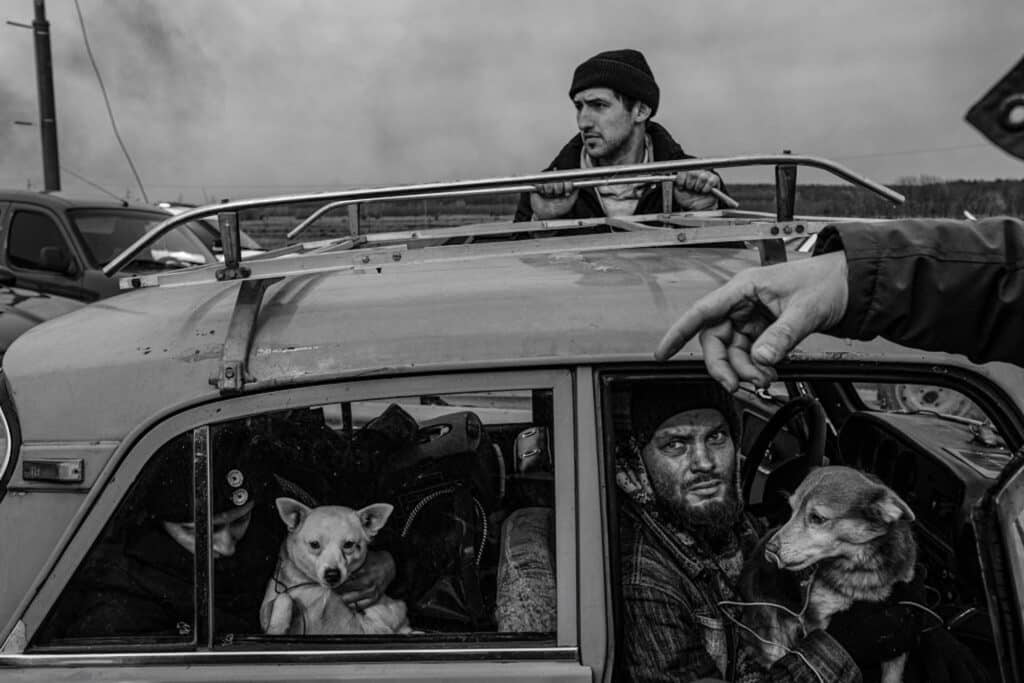
Like Bronstein, photojournalist Finbarr O’Reilly has covered conflict and its aftermath extensively. He arrived in Ukraine in April, about 6 weeks after the start of the war. While he works day-to-day to document what is happening during the conflict, he hopes that the photographs inform both the public and people in power to enable them to make more informed decisions. But he is also aware that while many journalists like himself are able to rotate in and out of the conflict zone, the Ukrainian journalists covering the war are in a much different situation. “I think the work, in particular by a number of Ukrainian journalists, has been really powerful. You can see that in this book and all the more so for the fact that they are documenting war in their own country and have to live with it in ways that those of us who are coming in for rotations of a couple of months at a time are not having to live with.”
“You can watch as much as you like through magazines, YouTube, and television, watch films, and read books, but until the war comes to you, you will never understand what it really is”
Maxim Dondyuk
Dondyuk echoes this message. Living with war day in and day out has taken a toll. “I cannot get used to the fact that there is not a single day without war. You can watch as much as you like through magazines, YouTube, and television, watch films, and read books, but until the war comes to you, you will never understand what it really is.”
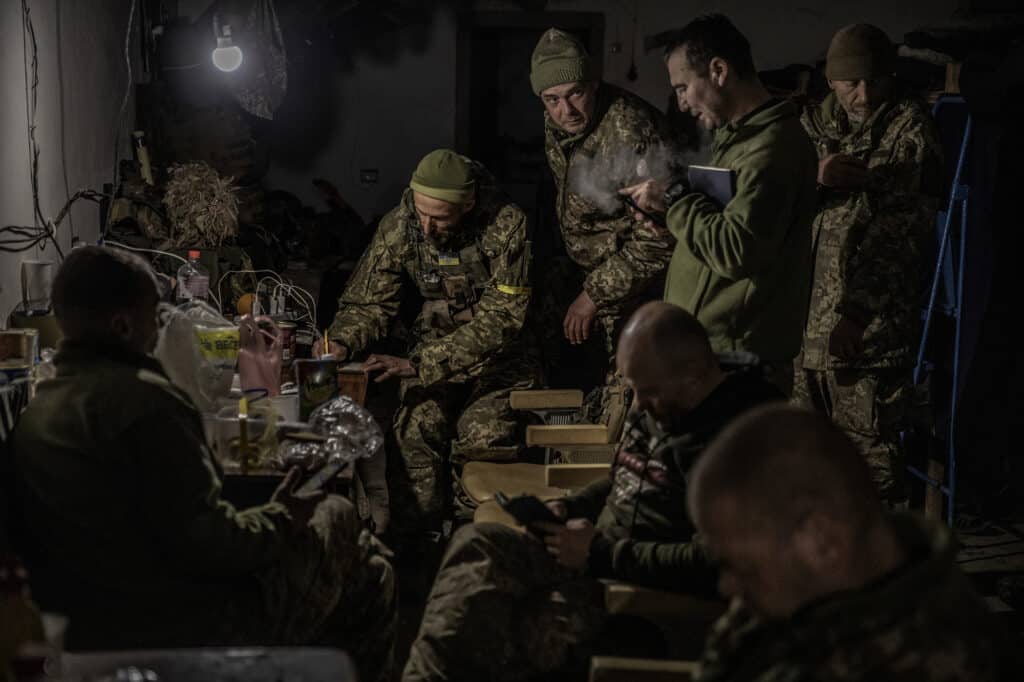
The war has also claimed the lives of 17 journalists as of this writing, according to the Committee to Protect Journalists. The Reuters Institute has also documented the losses among journalists, and created a database with information about them.
But the journalists themselves are not the only ones at risk. O’Reilly also added the importance of those on the ground in Ukraine who help support the journalists and who have the knowledge and connections that they need in order to do their jobs. “And then, of course, the local producers, translators, drivers, and everybody who we work with, they’re the ones who more than facilitate the work that those of us who are coming from outside the country perform. And we rely so heavily on their knowledge, expertise, and contacts to be able to get us the kinds of access that we need.”
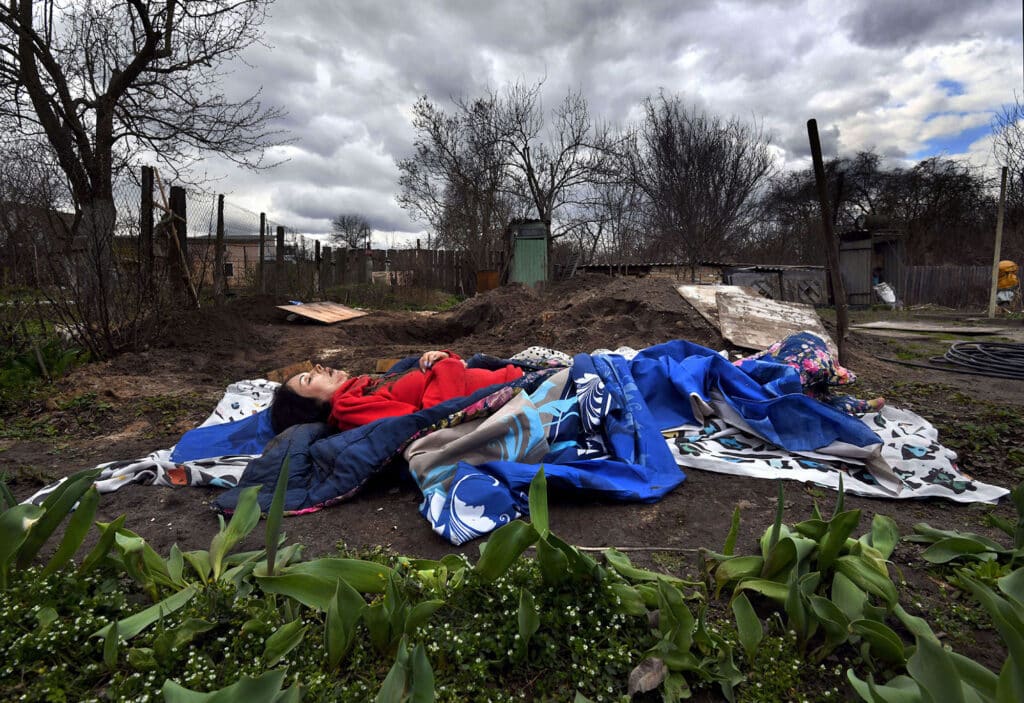
A powerful document
All of the photographers I spoke to for this article mention that they hope that their photographs and accounts will both document what is going on, as well as create a historical record. Mykhaylo Palinchal, a Ukrainian photographer, put it this way. “Photographers, as well as all the other journalists, work not only to spread information about what going on in this place, but also to preserve memory for future. I hope this book will help raise awareness in its audience about the situation in Ukraine.”
Ukraine: A War Crime is a powerful document. It works to not just spread information about the horrors of this war but also the hard evidence of the war crimes that have been committed. It is the proof of what has been done on Ukrainian soil, no matter how many denials there are. While human memory may fade, stories will be spun to suite certain sides, and interest will turn to other topics, this book ensures that what has happened so far in Ukraine will not disappear or be erased. And that those responsible will, at least one day, face the consequences for what they have done.
O’Reilly tells graphically of the evidence that it contains. And while the wheels of justice turn slowly, they do turn. “I have a series of images in the book of a communal grave in a small town outside Kherson, where, from the evidence we were able to gather, civilians had been executed by Russian forces during the occupation. But these things, from my experience with conflicts and war crimes investigations, take years and sometimes decades to play out. But having that initial evidence and documentation of what was found at the time is often crucial to these investigations.”
“This is forensic evidence. This is a record”
Finbarr O’Reilly
When I asked Leen about what she hopes the book will accomplish, or what she wants people to take away from the book, this was her answer. “I will quote Volodymyr Demchenko, a Ukrainian journalist, now soldier, who wrote the introduction of Ukraine: A War Crime: ‘The grass is growing on the graves, the ruins are being rebuilt, the smell of blood and decomposed bodies disappears with a new spring, and it becomes quite difficult to believe what was obvious yesterday.’ I want the book Ukraine: A War Crime to remain as visual evidence of the violence and war crimes committed on Ukrainian soil and to serve as a powerful tool for mobilization, legal prosecution, and as an historical document for future generations.”
“This is forensic evidence. This is a record,” O’Reilly adds. “I think it’s also an opportunity to take a step back from the first year, the daily news coverage, and have editors and people looking at the bigger picture determining some of the defining images of this conflict so far, and gathering them into a collection that we can look at now, as a historical record of what has happened in the first stages of this conflict, because this does appear to be a conflict that will continue and potentially last for years to come.”
Ukraine: A War Crime, 540 pages, 366 color and black and white photographs, 20x32cm, bi-lingual in Ukrainian and English, printed in April 2023. Available for purchase though the FotoEvidence website’s store.
